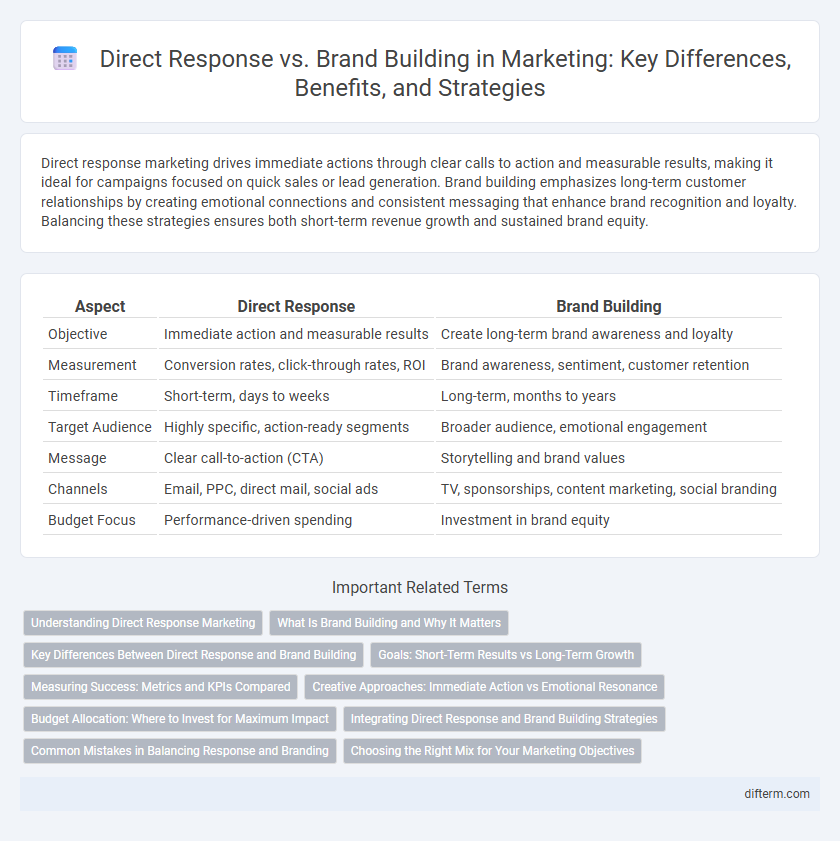Direct response marketing drives immediate actions through clear calls to action and measurable results, making it ideal for campaigns focused on quick sales or lead generation. Brand building emphasizes long-term customer relationships by creating emotional connections and consistent messaging that enhance brand recognition and loyalty. Balancing these strategies ensures both short-term revenue growth and sustained brand equity.
Table of Comparison
| Aspect | Direct Response | Brand Building |
|---|---|---|
| Objective | Immediate action and measurable results | Create long-term brand awareness and loyalty |
| Measurement | Conversion rates, click-through rates, ROI | Brand awareness, sentiment, customer retention |
| Timeframe | Short-term, days to weeks | Long-term, months to years |
| Target Audience | Highly specific, action-ready segments | Broader audience, emotional engagement |
| Message | Clear call-to-action (CTA) | Storytelling and brand values |
| Channels | Email, PPC, direct mail, social ads | TV, sponsorships, content marketing, social branding |
| Budget Focus | Performance-driven spending | Investment in brand equity |
Understanding Direct Response Marketing
Direct response marketing centers on eliciting immediate actions from consumers, such as clicks, purchases, or sign-ups, using data-driven strategies and measurable metrics. It leverages targeted messaging, strong calls-to-action, and multi-channel campaigns to optimize conversion rates and return on investment (ROI). Employing tools like A/B testing and customer analytics enhances campaign precision, enabling marketers to rapidly adjust tactics based on real-time performance data.
What Is Brand Building and Why It Matters
Brand building establishes a company's identity and emotional connection with customers through consistent messaging, visual elements, and values. It enhances brand recognition, customer loyalty, and long-term trust, creating a competitive advantage over time. Effective brand building increases perceived value, enabling premium pricing and sustained market share growth.
Key Differences Between Direct Response and Brand Building
Direct response marketing emphasizes immediate actions and measurable results through targeted campaigns, often using clear calls-to-action and performance tracking. Brand building focuses on long-term relationship development by enhancing brand awareness, loyalty, and emotional connection with the audience. Key differences lie in time horizon, measurement metrics, and communication style, with direct response driving short-term conversions and brand building strengthening sustained market presence.
Goals: Short-Term Results vs Long-Term Growth
Direct response marketing targets immediate consumer actions such as clicks, sign-ups, or purchases, aiming to generate measurable short-term results and rapid ROI. Brand building focuses on establishing emotional connections and increasing brand equity over time, fostering customer loyalty and sustainable long-term growth. Balancing direct response tactics with strategic brand-building efforts ensures a comprehensive marketing approach that drives both instant conversions and enduring market presence.
Measuring Success: Metrics and KPIs Compared
Direct response marketing prioritizes measurable metrics such as click-through rates, conversion rates, and return on ad spend (ROAS) to evaluate immediate campaign effectiveness. Brand building focuses on long-term KPIs like brand awareness, customer lifetime value (CLV), and brand equity, which are tracked through surveys, social listening, and market share analysis. Comparing these metrics highlights direct response's emphasis on short-term performance against brand building's strategy for sustained growth and customer loyalty.
Creative Approaches: Immediate Action vs Emotional Resonance
Direct response marketing leverages compelling calls-to-action and clear benefits to drive immediate consumer engagement and measurable results. Brand building prioritizes emotional resonance through storytelling, creating lasting connections that enhance brand loyalty and recognition over time. Balancing urgent messaging with authentic narratives optimizes overall marketing effectiveness and audience impact.
Budget Allocation: Where to Invest for Maximum Impact
Allocating marketing budgets between direct response and brand building requires balancing short-term sales impact with long-term brand equity growth. Direct response campaigns typically deliver measurable ROI through immediate customer actions, making them ideal for conversion-driving investments. Brand building investments foster strong brand recognition and loyalty, which enhance customer lifetime value and support sustained revenue growth over time.
Integrating Direct Response and Brand Building Strategies
Integrating direct response and brand building strategies enhances marketing effectiveness by combining immediate customer engagement with long-term brand loyalty. Data-driven direct response campaigns generate measurable conversions and optimize spend, while brand building establishes emotional connections and trust essential for sustained growth. Balancing performance metrics with brand equity creates a harmonious approach that drives both short-term sales and enduring market presence.
Common Mistakes in Balancing Response and Branding
Marketers often mistake short-term sales spikes from direct response campaigns as sustainable growth, neglecting long-term brand equity essential for customer loyalty. Overemphasizing immediate metrics like click-through rates can undermine brand perception and reduce future engagement value. Ignoring consistent brand messaging while chasing quick conversions leads to fragmented consumer experiences and diminished overall marketing effectiveness.
Choosing the Right Mix for Your Marketing Objectives
Choosing the right mix between direct response and brand building depends on your marketing objectives, target audience, and budget allocation. Direct response drives immediate actions through measurable campaigns like email marketing and pay-per-click ads, while brand building enhances long-term customer loyalty and market positioning via storytelling and consistent brand messaging. Combining data-driven tactics with creative strategies optimizes return on investment and sustainable growth in competitive markets.
direct response vs brand building Infographic

 difterm.com
difterm.com